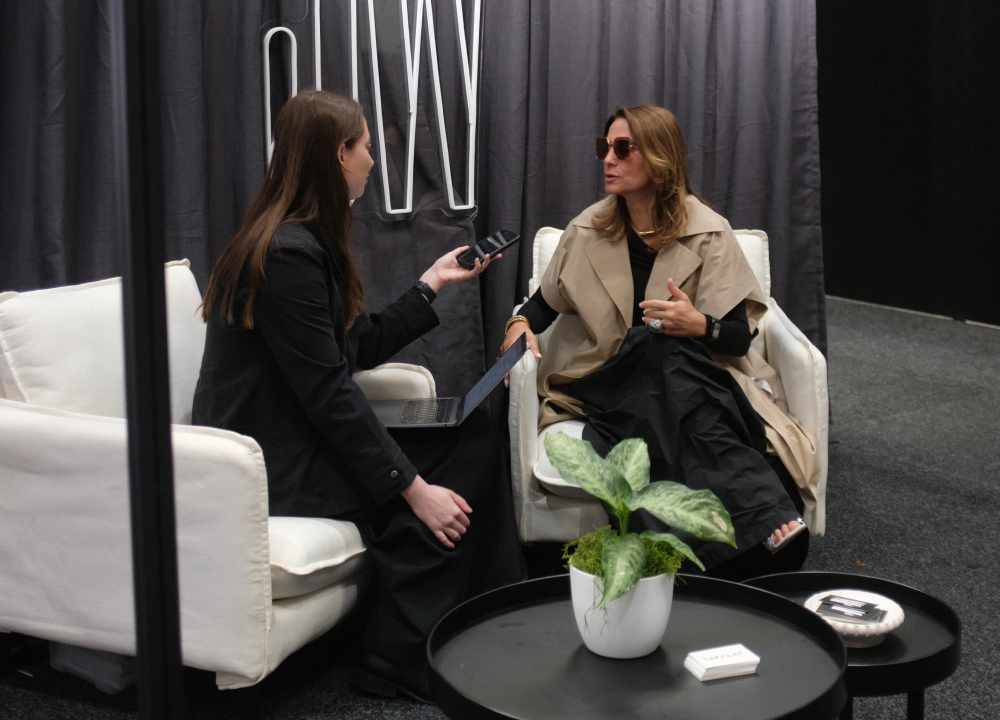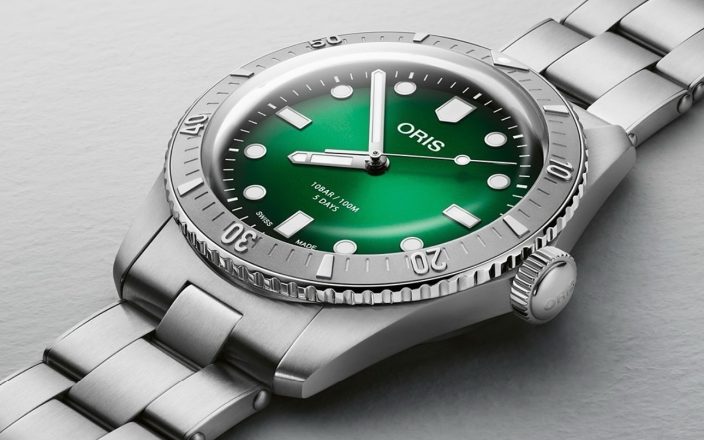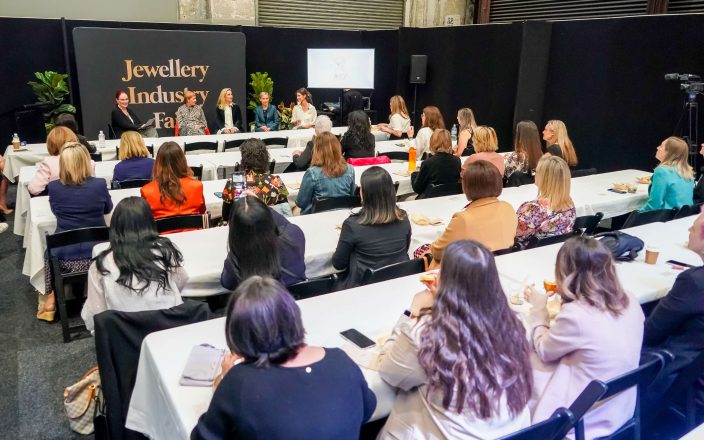Recently, at the Jewellery Industry Fair, Ashie Luke spoke to Paola De Luca, chief executive officer of The Futurist and founder and creative director of Trendvision Jewellery + Forecasting.
AL: Your international background has exposed you to a wide range of cultural influences. How has cultural diversity informed your creative process and your understanding of what resonates with different markets?
PDL: Well, having an international perspective is a key factor of my career, perspective, vision, [and] values. I [also] have to say success, even though I don’t know what success really means. I would say it’s a privileged platform because when you see things from a cultural perspective—everything makes more sense. After all, things are interconnected. So when you see things from here rather than here, you see things more broadly, and it’s easier to connect phenomenon, culture, [and] values, and it opens your mind, and when you have your open mind, you’re [can] absorb diversity.
AL: Absolutely, I completely agree. How did your early experiences in goldsmithing, metalwork, fashion, and art and design in Rome shape your perspective on the global jewellery industry?
PDL: [It] started as my love when I was younger… the arts. I was into art and fashion, and I won a scholarship. I started goldsmithing and doing some design, and I was very good at it, but [I] was so hungry for the world since then. I [must] admit I started quickly because I could design and make what I had in mind. That gave me the fast entry to the industry, but my nature was not to be a benchmaker. My nature was to sell cultures and world and travel, and bridging the world of, let’s call it fashion, but more than fashion, it’s like style and cultures and jewellery. So my strength was looking at people, developing styles, and [making] it happen.
PDL: Pretty quickly I went from making jewellery [to] designing jewellery [to] art directing, and then I had designers working for me because, in my 20s, I started selling jewellery collections rather than a piece of jewellery. At that time, I was in New York. Rome, for me, was a small city because I was hungry very quickly. So in [the] early 90s, I was in New York and I quickly had the opportunity to [work] at Fendi… I didn’t think it was easy for me because I was there at 22 years old. I was very privileged. I went from nothing to top fashion in the world—Karl Lagerfeld, Carla Fendi, and I was in Manhattan, I just lived my dream, but it wasn’t a dream for me. It felt very natural. I have to tell you, it didn’t feel weird! It felt like that was it.
AL: You were meant to be there.
PDL: I was! And to me, what I loved was going from the underground culture. I was into the night scene. I was into [the] street styles. To me, it was just very natural. And that was it.
AL: As you said, you’ve collaborated with renowned luxury brands like Fendi, Salvatore Ferragamo, and Harry Winston. Can you share a specific project you consider significant regarding your creative growth?
PDL: The first one, of course, was designing jewellery for Fendi. It was very important because we launched the first jewellery collection, and the pasta collection was inspired [by] pasta. The idea was from Karl Lagerfeld. It is something that I was part of from the beginning [of] the presentation to the launch of the line. I was privileged enough. I was very young, so I went from the beginning to the end, meaning that from the beginning [of] the launch, we put together an exhibition. I worked under the wing of Carla Fendi, which only now I realise, I was working with icons at this point. And that was very meaningful. Another important project was when I worked with Fulvia Ferragamo Visconti. I was also working with her directly, working on a homeware collection. And so I was going from New York to Florence to Milano. It was very incredible to see how they worked.
PDL: Another important project that made me feel like… I pinched myself when I worked for Fossil. They had the license for Armani, Emporio Armani Gioielli. I was their key person dealing with the Armani company in Milano. When we presented the collections, I was the one that was in front of Mr. Giorgio Armani. I remember the first time I had to present to him, I was not intimidated because I always was very confident. But I went next to him, and I started presenting. He says, “Don’t tell me anything because I want to look at things without any influence. I don’t want anybody to tell me what’s going on. I want to see it first, and then I will get back to you.” He started looking at it. I was next to him. And then all of a sudden, he picks it, a bracelet, part of the collection that I was designing. He showed it to me. He’s like, “Well, this looks very cool. I like it. What do you think?” And I was like, damn, Giorgio Armani is asking me what I think! I said, “Well, I presented it, so I feel comfortable with that—if you like it, I’m honoured. I’m pleased.” It was a moment in my life where I felt special because of that.
AL: Of course. That would be very special, especially being so young as well. Your role as design director of Rio Tinto offered a unique blend of design, leadership and education. How do you balance the creative process with the educational aspects when working with people from various backgrounds?

PDL: That is the most rewarding and challenging time. Talent you [are] born with, but [you must] refine talent with methodology and system. What I’ve learned throughout my long career is being humble. You never arrive. You’re never achieved in a way. There is always room for improvement. Every time I go somewhere, [I practice] not being judgmental. I practice being humble, [and] listening, because everybody from a young kid to an older person, it doesn’t matter the social rank, I always absorb. This has been my path. I don’t know if it’s a secret because I always talk about this, but my system is to [be] very humble. When I worked at Rio Tinto, I went everywhere with the idea of using a methodology. Listening to people, [their] words, but also their body language and their silent language. Being empathic with people gives you the direction and the solution of how to apply your methodology to their local cultures. And hopefully, you are successful, not because you are, but because we are successful together.
AL: Absolutely. Empathy is key in any situation. Creating the TJF Trend Book has marked a significant milestone in your career. What inspired you to take on the role of a trend forecaster, and how do you believe this impacted the direction of the jewellery industry?
PDL: Well, I started in the early 90s because at that time, I had someone who was my boss, who was coming from Prada, and he wanted to implement trend forecasting for fashion into the jewellery industry. So that’s how I started it, and it took me 30 years to perfect it. Trend forecasting translates into market research social, cultural shifting and consumer culture, compacting it and packaging it for the industry and being able to brief designers, marketers, and the executive team into applying it to the production cycle, marketing, and so on. So, trend forecasting is the beginning of strategy for any company. So I was blessed that I was stimulated by this director that was my boss at that time, and it happened by chance and became my main career of strength. I didn’t decide on it—it just happened on its own. But 30 years later, it [seemed] like trend forecasting chose me, and I embraced it.
AL: Yes, so again, you were just meant to be there, meant to be doing it.
PDL: It was meant to be. I didn’t do anything—it just happened!
AL: Could you provide insights into how you identify emerging trends and translate them into innovative designs that resonate with consumers?
PDL: Well, trends are mainly divided by simplifying macro trends and micro trends. Macro trends [are] everything that implies a global transformation and impact every sector and every aspect of human life. Climate change is a macro trend—it is a phenomenon that is impacting. The ageing population is impacting. Geopolitical changes are impacting. Civil rights and equality, and gender equality are impacting. So those are examples of the digital age as a macro trend. The jewellery sector is impacting consumer culture, therefore, the way we [style] ourselves, the way we [buy], the way we [perceive] culture, jewellery styling, communication. So we collect data, both statistical and quantitative data, but also qualitative data, and also semiotics, meaning imagery. So if we can give a code to imagery, like image recognition, selection with software and AI, that’s what we do. It’s simplified by digital, the hashtag in analytics, we [can] collect data, analyse data, and make projections. That’s how we come up.
AL: What advice would you give to an aspiring designer or professional looking to make a meaningful impact in the jewellery industry?
PDL: Follow your instinct and study. That’s what I would do—that’s what I did. Follow your instinct, meaning, heart and talent, and have a holistic approach, but there is no shortcut. I strongly believe that studying and putting in the time is the way to go. Before I [spoke] with the designer, she said, “What can I do to be successful in the Australian market?” And I said, “Do you know what you want? Do you know who you are? And have you studied? Did you go [to] the stores? Did you study trends in terms of sales? Did you study retail business in Australia or any parts of the world?” So not only do you have to study, but you have to understand, learn methodology, have a system, and have a discipline. And that less is more, meaning that the more you study, the more you are strategic, and by having a strategic approach, you’re going to be successful. It doesn’t work otherwise.
AL: Well, speaking of Australia, it’s your first time here and your first presence at the jewellery industry fair, which has generated a lot of excitement. What are you most looking forward to experiencing during your time here, and how do you anticipate the Australian jewellery industry and creative scene might differ from your previous experiences?
PDL: I’m very happy to be here and very excited. I am very impressed by the attitude of Australians. I think there is great creativity here. I think we are at the beginning of something huge. You guys [points to Ashie], being the young generation in Australia, [can] start from a very good beginning, a good start. Not only can you be successful in Australia, but you can be successful abroad. I think that being a cultural melting pot and also developing an Australian culture enables you to be very successful. I see a lot of creativity. There is, of course, a market journey and development to be done, which is great because I like the holistic approach of Australians. Having a particular love for life, and this is not something negative, I think it is great. I think that it’s very modern, it’s very in the now. It’s like celebrating life and working and celebrating. That’s what it’s all about. It’s not just about selling jewellery, selling gold, making money. I think you guys can be the present and future of the jewellery industry.
AL: It’s nice to hear you say that. Lastly, on a more personal note, what motivates you and inspires you to continue pushing [the] boundaries of creativity and innovation in the jewellery industry?
PDL: My love for innovation, my love for the best is yet to come, of overcoming challenges, of learning. I’m still hungry for knowledge. Every day I live my day as if it was the last day of my life, and every day I push and I ask myself, what’s next?


